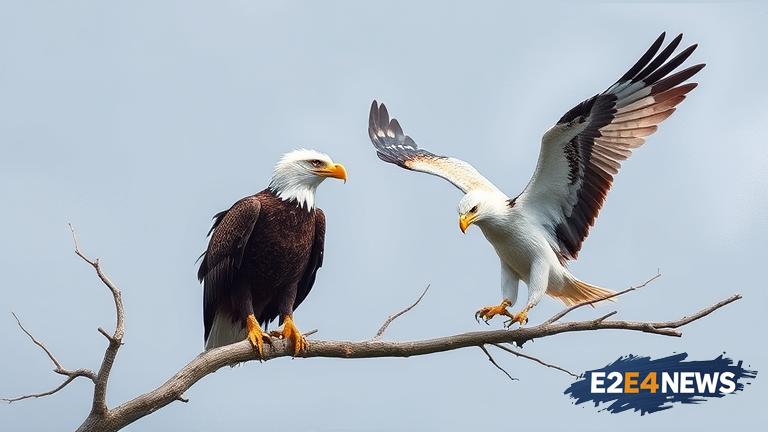The Chesapeake Bay, known for its rich biodiversity, has witnessed a significant recovery of bald eagles in recent years. This resurgence has been hailed as a conservation success story, but it has also raised red flags for another iconic bird species, the osprey. The bald eagle, once an endangered species, has made a remarkable comeback, with its population increasing by over 50% in the past decade. However, this growth has led to increased competition for food and habitat, posing a threat to the osprey population. Ospreys, also known as fish hawks, are specialized birds that feed primarily on fish, and their population has been declining in recent years. The main reason for this decline is the lack of food availability, as bald eagles are competing with ospreys for the same fish species. Furthermore, bald eagles are known to be aggressive and have been observed stealing food from ospreys, a behavior known as kleptoparasitism. This behavior has been documented in several studies, which have shown that bald eagles are responsible for a significant proportion of osprey food theft. In addition to food competition, habitat destruction and degradation are also major concerns for osprey populations. The Chesapeake Bay region has experienced significant development and urbanization, leading to the destruction of natural habitats and the degradation of water quality. This has resulted in a decline in the availability of suitable nesting sites for ospreys, making it difficult for them to breed and raise their young. Conservation efforts are underway to protect osprey populations, including the installation of artificial nesting platforms and the restoration of natural habitats. However, more needs to be done to address the impact of bald eagle recovery on osprey populations. The U.S. Fish and Wildlife Service has launched an initiative to study the interactions between bald eagles and ospreys, with the goal of developing effective conservation strategies. The study will investigate the impact of bald eagle recovery on osprey populations, including the effects of food competition and habitat degradation. The results of the study will be used to inform conservation efforts and ensure the long-term sustainability of osprey populations. In conclusion, the recovery of bald eagles in Chesapeake Bay is a complex issue that requires careful consideration of the potential impacts on other species, including ospreys. While the resurgence of bald eagles is a conservation success story, it is essential to address the concerns raised by osprey populations and work towards finding a balance between the two species. The conservation of osprey populations requires a multi-faceted approach that includes the protection of natural habitats, the restoration of water quality, and the mitigation of food competition. By working together, we can ensure the long-term sustainability of osprey populations and maintain the rich biodiversity of the Chesapeake Bay region. The recovery of bald eagles is a testament to the effectiveness of conservation efforts, but it also highlights the need for continued vigilance and action to protect other species. The osprey population is an important indicator of the health of the Chesapeake Bay ecosystem, and its decline is a warning sign that requires immediate attention. The U.S. Fish and Wildlife Service, in partnership with other conservation organizations, is committed to protecting osprey populations and ensuring the long-term sustainability of the Chesapeake Bay ecosystem. The conservation of osprey populations is a complex issue that requires careful consideration of the potential impacts of bald eagle recovery, as well as the effects of habitat degradation and food competition. By addressing these concerns and working towards a balance between species, we can ensure the long-term sustainability of osprey populations and maintain the rich biodiversity of the Chesapeake Bay region.
